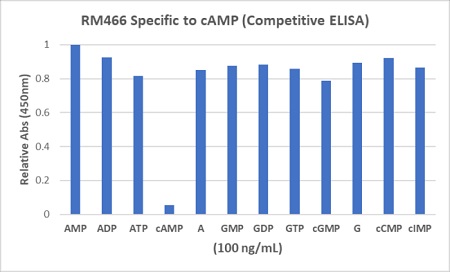
Competitive ELISA showing the specificity of anti-cAMP (RM466). The 96-well plate was coated with 1 ug/mL of Goat anti-rabbit IgG (50 microl/well). 0.05 microg/ml of anti-cAMP (RM466) (50 microl/well) was added and incubated. After wash and block, cAMP and other cyclic nucleotides or nucleoside phosphates (25 microl/well) were added along with 25 microl/well of 1/5,000 diluted HRP conjugated cAMP. TMB was used to develop the color after incubation and wash.
anti-cAMP, Rabbit Monoclonal (RM466)
REV-31-1358-00
ApplicationsELISA
Product group Antibodies
ReactivityAll Species
Overview
- SupplierRevMAb Biosciences
- Product Nameanti-cAMP, Rabbit Monoclonal (RM466)
- Delivery Days Customer10
- Antibody SpecificityRM466 reacts to cAMP (Cyclic Adenosine Monophosphate). No cross-reactivity with other cyclic nucleotide or nucleoside phosphate.
- ApplicationsELISA
- CertificationResearch Use Only
- ClonalityMonoclonal
- Clone IDRM466
- Concentration1 mg/ml
- HostRabbit
- IsotypeIgG
- Scientific DescriptionCyclic adenosine monophosphate or cAMP is an intracellular by-product of ATP by adenylene cyclase when G-protein Coupled Receptors (GPCR) bind various ligands on the cell surface. Cyclic AMP acts as a second messenger for signal transduction across the cell membrane and is a part of kinase activation. It regulates the effects of glucagon and adrenaline along with the movement of calcium ions through ion channels. Since it is affected directly by GPCR activation, cAMP is studied as a means to monitor GPCR in the discovery of therapeutic drugs. - Recombinant Antibody. RM466 reacts to cAMP (Cyclic Adenosine Monophosphate). No cross-reactivity with other cyclic nucleotide or nucleoside phosphate. Isotype: Rabbit IgG. Immunogen: KLH-conjugated cAMP. Applications: ELISA. Liquid. 50% Glycerol/PBS with 1% BSA and 0.09% sodium azide. Cyclic adenosine monophosphate or cAMP is an intracellular by-product of ATP by adenylene cyclase when G-protein Coupled Receptors (GPCR) bind various ligands on the cell surface. Cyclic AMP acts as a second messenger for signal transduction across the cell membrane and is a part of kinase activation. It regulates the effects of glucagon and adrenaline along with the movement of calcium ions through ion channels. Since it is affected directly by GPCR activation, cAMP is studied as a means to monitor GPCR in the discovery of therapeutic drugs.
- ReactivityAll Species
- Storage Instruction-20°C
- UNSPSC12352203
